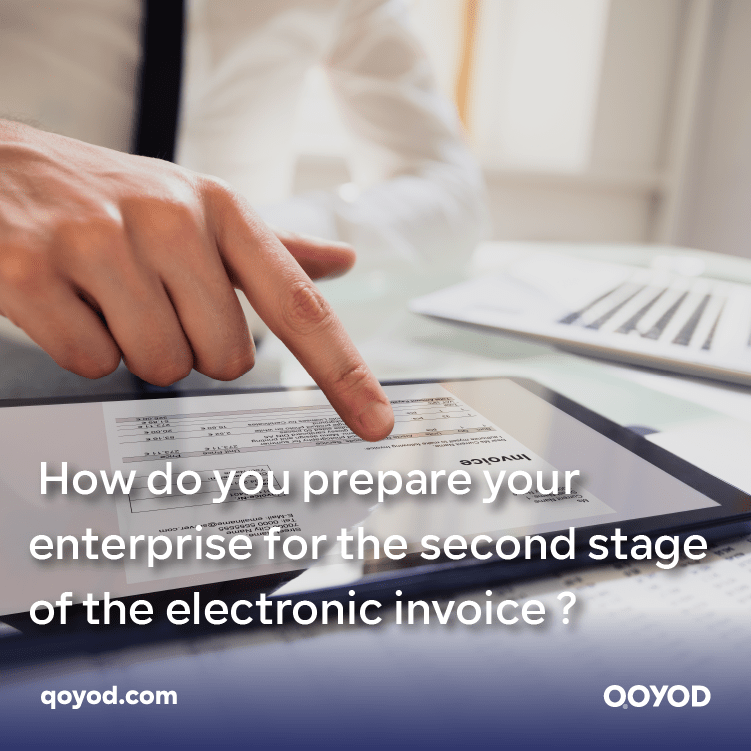The Zakat, Tax, and Customs Authority (“Zakat and Income Authority) has launched the electronic invoicing system to replace it with a paper invoicing system, seeking to catch up with the world’s leading countries and responding to the rapid growth in the Saudi business environment.
The system was launched with the launch of the first phase of the electronic invoice, to be announced by the Zakat Tax and Customs Authority and the Zakat and Income Authority for the implementation of the second phase of the electronic invoice.
This invoice is a trade document for requesting or proving the value of the amount to be paid for the purchase, with a tax invoice containing all the requirements of the tax invoice.
What are the stages of the electronic invoice?
There are two phases to the transition to the electronic invoice:
First stage
It started on December 4, 2021.
This stage requires taxpayers to issue invoices and store them electronically in an electronic billing system that complies with the requirements approved by the Zakat, Tax, and Customs Authority.
Second stage
The second phase of the e-invoice started on January 1, 2023, in a phased manner. This phase is known as “integration linkage” and is an extension of the first phase.
At this stage, the taxpayer’s electronic invoicing systems must be linked to the system of the Zakat, Tax, and Customs Authority (“Zakat and Income Authority) through the Fatora platform in order to facilitate the circulation of data, approve invoices and taxes, and ensure the validity of their data.
Read also: What is an electronic invoice?
Electronic invoices must also be issued in the required format.
The second phase of the electronic invoice will be implemented in a phased manner, provided that the Zakat, Tax, and Customs Authority (“Zakat and Income Authority) notifies those in charge of the second phase at least 6 months before its implementation.
Who needs to apply for e-invoicing?
The Zakat, Tax, and Customs Authority (“Zakat and Income Authority) announced that the category to which the electronic invoice will be applied is all taxpayers subject to Value Added Tax (VAT), except for non-residents in the Kingdom.
In addition to the companies selected based on the size of their revenues for 2021, with a minimum of 3 billion riyals annually,
Electronic invoicing will also apply to any entity that issues tax invoices on behalf of a taxable taxpayer.
How do you prepare your enterprise for the second phase?
First, Your establishment must have a cloud billing system that meets the conditions that the Zakat, Tax, and Customs Authority set.
For this, Qoyod offers you a comprehensive and easy-to-use electronic billing system that meets all the conditions that the Zakat, Tax, and Customs Authority requires.
Through Qoyod, all you have to do is “click a button” to activate the electronic invoice in your establishment.
What conditions do I need to provide?
In order for the commissioned establishment to be ready for the second phase, it must meet the following requirements:
- Adopting an electronic invoicing system compatible with the requirements of the second stage of the electronic invoice
The billing system must have the ability to issue and save electronic invoices in XML format, or PDF/A-3, including XML format, with all required fields included.
The establishment must ensure that its electronic billing system is compatible with all electronic invoicing requirements, such as being cloud-based and connected to the Internet.
- Share invoices with the Fatora platform, which the Zakat, Tax, and Customs Authority launched.
- Compliance with the Kingdom’s data security rules
The invoice must contain a QR code, with no ability to falsify or manipulate invoices from the billing system used.
Read also: Everything you need to know about e-invoice
What are the penalties if the establishment does not comply with the implementation of the electronic invoice?
The e-invoice is mandatory for all those subject to the Saudi VAT regulation system or for any person issuing the e-invoice in the Kingdom of Saudi Arabia.
Establishments that refrain from implementing the electronic invoicing system will be subject to the fines regulations that exist within the regulations and regulations for the application of VAT within the Kingdom of Saudi Arabia.
With a grace period in which the taxpayer and billing are prepared, so that the period does not exceed the time of applying electronic tax invoicing in Saudi Arabia.
E-invoice Frequently asked questions for the second stage
- How are the registration and linking done in the second stage of the electronic invoice?
After The Zakat, Tax, and Customs Authority informs you that you are obligated to participate in the second phase of the e-invoice, you should ensure that your establishment’s e-invoicing program supports this stage.
You are free to choose a billing system that suits your needs, provided that it has the option to link with the Authority’s Fatora platform so that your tax operations are disciplined.
1: What does the simplified tax invoice in the second stage contain?
The simplified tax invoice contains the following fields:
- Invoice address (simplified tax invoice)
- Time and date of issuance of the invoice.
- Serial number.
- Seller Information.
- Buyer information.
- QR Code.
- Store address.
- VAT registration number.
- The amount of each product is inclusive of VAT.
- Total invoice amount (inclusive of VAT).
2: What does the comprehensive tax invoice in the second stage contain?
- Invoice address (tax invoice)
- Date and time of issuance of the invoice
- Serial number.
- Seller Information.
- Buyer information.
- QR Code.
- The commercial registration number of the supplier (or any other identifier)
- Total invoice price (excluding VAT).
- Total invoice price (inclusive of VAT).
Read also: Learn more about the advantages of Qoyod through this video.
How do I increase my knowledge and take full precautions?
Qoyod has created a help center that includes everything you need to know about electronic invoicing and the stages of e-invoicing.
In addition to free courses that help you learn about the features that suit your organization, we publish them periodically on our Twitter account.
The Conclusion
The electronic invoicing system is a procedure that aims to transform the process of issuing paper invoices into an electronic process that allows the exchange of invoices and debit and credit notes and processes them in an organized electronic format between the seller and the buyer in an integrated electronic format.




